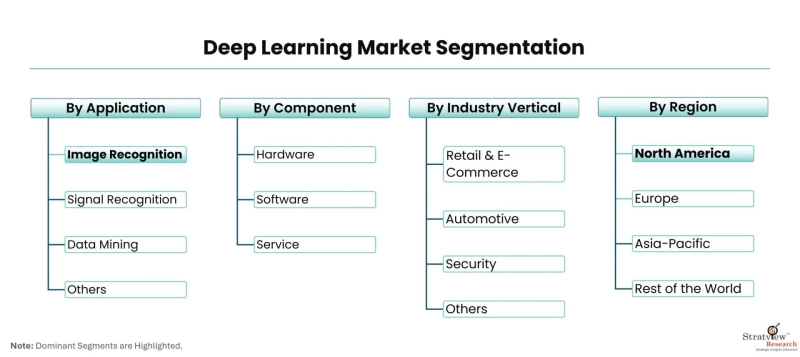Deep learning, a subset of artificial intelligence (AI) and machine learning (ML), has rapidly emerged as a transformative force across multiple industries. Leveraging neural networks that mimic human brain functions, deep learning enables machines to analyze vast amounts of data, recognize patterns, and make decisions with unprecedented accuracy. This article delves into the key trends and insights driving the growth of the deep learning market.
Market Growth and Adoption
The deep learning market has witnessed exponential growth in recent years, propelled by advancements in computing power, the proliferation of big data, and increasing investment in AI research and development. Businesses across various sectors, from healthcare to finance, are adopting deep learning technologies to enhance their operations, improve decision-making, and gain a competitive edge. According to Stratview Research, the deep learning market was estimated at USD 42.6 billion in 2022 and is likely to grow at a CAGR of 34.19% during 2023-2028 to reach USD 255.75 billion in 2028.
Key Trends Shaping the Market
Integration with Big Data and Cloud Computing: The synergy between deep learning and big data is a significant driver of market growth. Deep learning algorithms require vast datasets to train and improve accuracy. The integration with cloud computing platforms provides the necessary infrastructure to store, process, and analyze these large datasets, making deep learning more accessible and scalable for businesses.Advancements in Hardware: The development of specialized hardware, such as Graphics Processing Units (GPUs) and Tensor Processing Units (TPUs), has revolutionized deep learning capabilities. These hardware advancements enable faster data processing and model training, reducing the time and cost associated with deploying deep learning solutions.Rising Demand in Healthcare: The healthcare industry is a major adopter of deep learning technologies. Applications such as medical image analysis, disease prediction, and personalized treatment plans are significantly improving patient outcomes. The ability of deep learning algorithms to analyze complex medical data and detect anomalies with high precision is driving its adoption in healthcare.Autonomous Vehicles and Robotics: Deep learning is at the core of the development of autonomous vehicles and advanced robotics. Self-driving cars rely on deep learning algorithms to interpret sensor data, recognize objects, and make real-time driving decisions. Similarly, robotics is leveraging deep learning for object recognition, navigation, and human-robot interaction.Natural Language Processing (NLP): NLP, powered by deep learning, is transforming how machines understand and generate human language. Applications such as chatbots, virtual assistants, and sentiment analysis tools are becoming more sophisticated, providing businesses with valuable insights and enhancing customer experiences.Challenges and Opportunities
Despite its rapid growth, the deep learning market faces challenges such as data privacy concerns, high implementation costs, and the need for skilled professionals. However, these challenges also present opportunities for innovation and development. Companies investing in robust data governance frameworks, cost-effective solutions, and talent development programs are well-positioned to capitalize on the deep learning revolution.
Conclusion
The deep learning market is poised for significant expansion, driven by technological advancements, increasing adoption across industries, and the continuous influx of data. As deep learning technologies evolve, they will unlock new possibilities, revolutionize business processes, and shape the future of AI. Understanding the key trends and insights in this dynamic market is crucial for businesses and stakeholders aiming to harness the full potential of deep learning.


